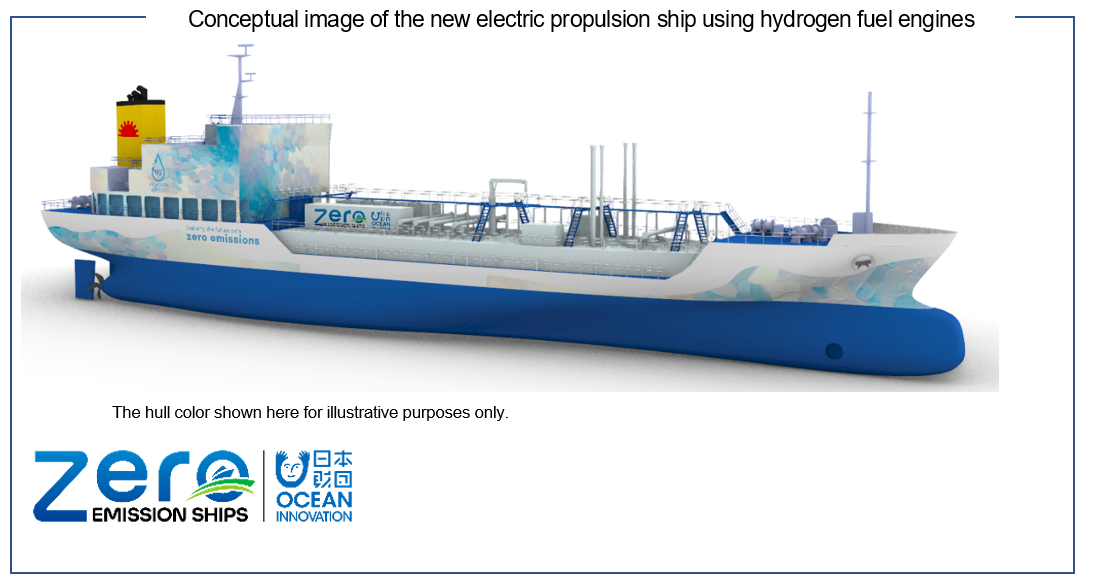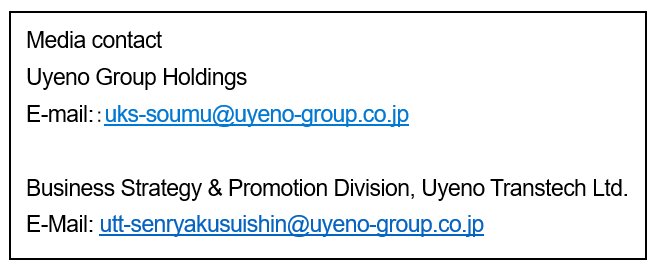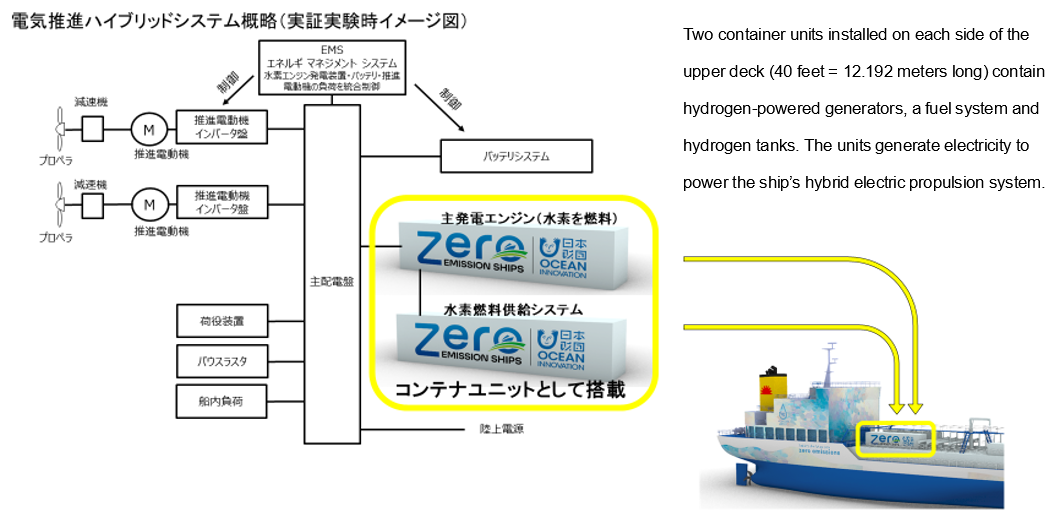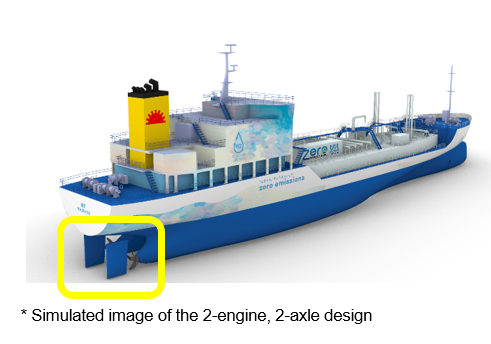- NEWS / ニュース
- 06.30.2023
- A Newbuilding of the Electric Propulsion Ship for the proof of concept with Hydrogen Engines on 5,200 dwt tanker in Japan. Hydrogen-powered Zero-emission Ship as ahead of the world.
Uyeno Transtech Ltd. (President & COO: Mr. Gen Uyeno, Headquarters: Naka-ku, Yokohama, hereinafter Uyeno Transtech), a shipping company of the Uyeno Group, announced the newbuilding of an electric propulsion ship to be delivered in 2025 for the proof of concept to be executed in 2026 by the technology development subsidy program targeting hydrogen fuel demonstration, a part of the Nippon Foundation’s zero emission ship demonstration experiment.
The new 5,200 dwt tanker, planning a length over all more than 100 meters and is not only based on a conventional ship, but also will be modified with a new designed hull form, a prototype of largest size for a hydrogen-fueled domestic coastal tanker.

Details of the Nippon Foundation’s zero emission ship demonstration experiment (in Japanese)
URL: https://www.nippon-foundation.or.jp/what/projects/zeroemission2050?site=hl21201041
■ About the Uyeno Group
The Uyeno group is comprised of 35 companies engaged in the transportation, storage and sales of petroleum and chemical products essential for industrial and civic life, as well as being engaged in ventures related to solar energy and marine environments. Since our establishment in 1869, we have made vast contributions to societal development stretching over a variety of business fields and have accumulated a wealth of experience and expertise over a span of more than 150 years.
Project name
Development and Demonstration of Marine Hydrogen 4-stroke Engine and Large Coastal Tanker Compatible with Hydrogen Engine.
Consortium members (as of June 2023)
1. Yanmar Power Technology Co., Ltd. (representative of this consortium)
2. Uyeno Transtech Ltd.
3. Kyoto University
4. Fukuoka Shipbuilding Co., Ltd.
5. Mitsui E&S Shipbuilding Co., Ltd.
6. Mirai Ships Inc.
*Roles: 4. Detailed design and shipbuilding, 5. Basic planning and basic design of the ship, 6. Detailed design and manufacturing of container units for hydrogen fuel engines
Key points of development of a hydrogen-fueled ship
In response to the challenges in managing hydrogen combustion, a hybrid power generation system combining a power generation unit and battery, has been adopted. This innovative approach entails installing a generator powered by the newly developed hydrogen fuel engine, together with the hydrogen fuel supply system, including hydrogen fuel tanks, in container on top of the upper deck of the ship. Successful implementation of the hydrogen fuel system on a ship of this size is expected to reduce CO2 emissions by about 6,000 tons per year compared to a ship using heavy fuel.
*1 Yanmar Power Technology Co., Ltd. is in charge of the development of the hydrogen fuel engine (hydrogen fuel 4-stroke high-speed power generation engine for coastal vessels)and hydrogen fuel supply system. This company is a group companies of Yanmar Holdings Co., Ltd. and develops, manufactures, sells and services engines.


電気推進ハイブリッドシステム概略(実証実験時イメージ図): Outline of system the hybrid electric propulsion system (concept image of demonstration experiment).
EMS / エネルギマネジメントシステム: energy management system
水素エンジン発電装置・バッテリ・推進電動機の負荷を統合制御: integrated control of hydrogen engine
generator, battery, and propulsion motor load
制御: control
プロペラ: propeller
減速機: decelerator
推進電動機: propulsion motor
推進電動機インバータ盤: propulsion motor inverter board
荷役装置: cargo handling equipment
バウスラスタ: bow thruster
船内負荷: onboard load
主配電盤: main switchboard
バッテリシステム: battery system
主発電エンジン(水素を燃料): main power generation engine (fueled by hydrogen)
水素燃料供給システム: hydrogen fuel supply system
コンテナユニットとして搭載: mounted as a container unit
陸上電源: onshore power
Main features of the new ship during the demonstration:
Scheduled completion: June 2025
Gross tonnage: 4,500 tons
Load capacity: 5,000KL
Length over all: 104.93m
Engine: Marine hydrogen fuel 4-stroke high-speed generator* (scheduled for completion in 2026)
* Yanmar Power Technology Co., Ltd. URL:
https://www.yanmar.com/jp/marinecommercial/news/2023/06/30/126380.html (in Japanese)
Using knowledge gained from this proof of concept, a hydrogen fuel engine that can be installed in the engine room of this new ship (the first concept of its kind in Japan) will be designed and developed, and then Approval in Principle (AiP)*3 will be obtained from Nippon Kaiji Kyokai (ClassNK)*2. This will make it possible to build hydrogen-fueled ships as soon as future hydrogen infrastructure such as supply chains and bunkering (supplying hydrogen to ships as fuel)are developed, leading to faster decarbonization.
*2 An organization that establishes regulations concerning the safety of hulls, outfitting, engines, etc. of ships, and conducts inspections to confirm compliance with the regulations regarding the structure and current status of individual ships. Nippon Kaiji Kyokai (ClassNK) is one of the many such organizations in the world and is a ship classification society in Japan.
*3 A scheme to examine technical feasibility from the perspective of regulations by examining drawings based on regulations for products in the basic stages of design.
■ About Nippon Foundation
Share the pain. Share the hope. Share the future.
Since its founding in 1962, The Nippon Foundation, Japan’s largest philanthropic foundation, funded by
the proceeds of Japanese motorboat racing, has pursued activities in a wide range of fields including support
for children and persons with disabilities, disaster relief, ocean affairs, and humanitarian aid
across racial and national borders.
https://www.nippon-foundation.or.jp/
■ About Yanmar
With beginnings in Osaka, Japan, in 1912, Yanmar was the first ever to succeed in making a compact diesel engine of a practical size in 1933. A pioneer in diesel engine technology, Yanmar is a global innovator in a wide range of industrial equipment, from small and large engines, agricultural machinery and facilities, construction equipment, energy systems, marine, to machine tools, and components — Yanmar’s global business operations span seven domains. On land, at sea, and in the city, Yanmar provides advanced solutions to the challenges customers face, towards realizing A Sustainable Future.
For more details, please visit the official website of Yanmar Holdings Co., Ltd.
https://www.yanmar.com/global/about/
Key development points of the new ship in addition to the demonstration experiment using hydrogen fuel
(1) Advanced ships targeting autonomous navigation Twin screwed with 2-engine and 2-axle (4 generators, 2 propulsion motors, 2 propeller shafts, and 2 rudders) is designed to improve the maneuverability of the vessel than conventional single-axle ships. Joystick would enable easy control and expect to help reduce accidents on berthing and unberthing. Since this will be a hybrid electric propulsion ship, it will be easy to integrate the ship maneuvering equipment (nerves) necessary for a ship capable of autonomous navigation and remote control in future and support as they are highly compatible with one another.

(2) Development of ships that makes people want to work on board (ride on ⇒ work on board)
One of our goal is to make (⇒ built)environmentally-friendly and crew-friendly ships. In addition to the features mentioned above, Uyeno Transtech aims to equip an automatic cargo handling system with automatic voice guidance, and machine vision camera to help Captain and/or crew to easier recognition of obstacles and at the end to improve safety. Furthermore, in order to improve the onboard living space, including cabins taking into account diversity and comfort, Uyeno Transtech develops ships that, from the perspective of seafarers, people want to work on board.
(3) Improved fuel economy
In line with the development of a hull form that can be navigated using a large and heavy hydrogen fuel engine and hydrogen fuel supply system on the deck during the proof of concept, the hull form will be developed to reduce resistance such as friction acting on the hull. In addition, by combining it with the effective power management resulting from the hybrid power generation system, it is possible to achieve more power than conventional hulls. Integrated control of the load on the power generation device and battery will realize a stable supply of the main power source. This will produce an 8 to 15% improvement in fuel efficiency compared with conventional vessels.